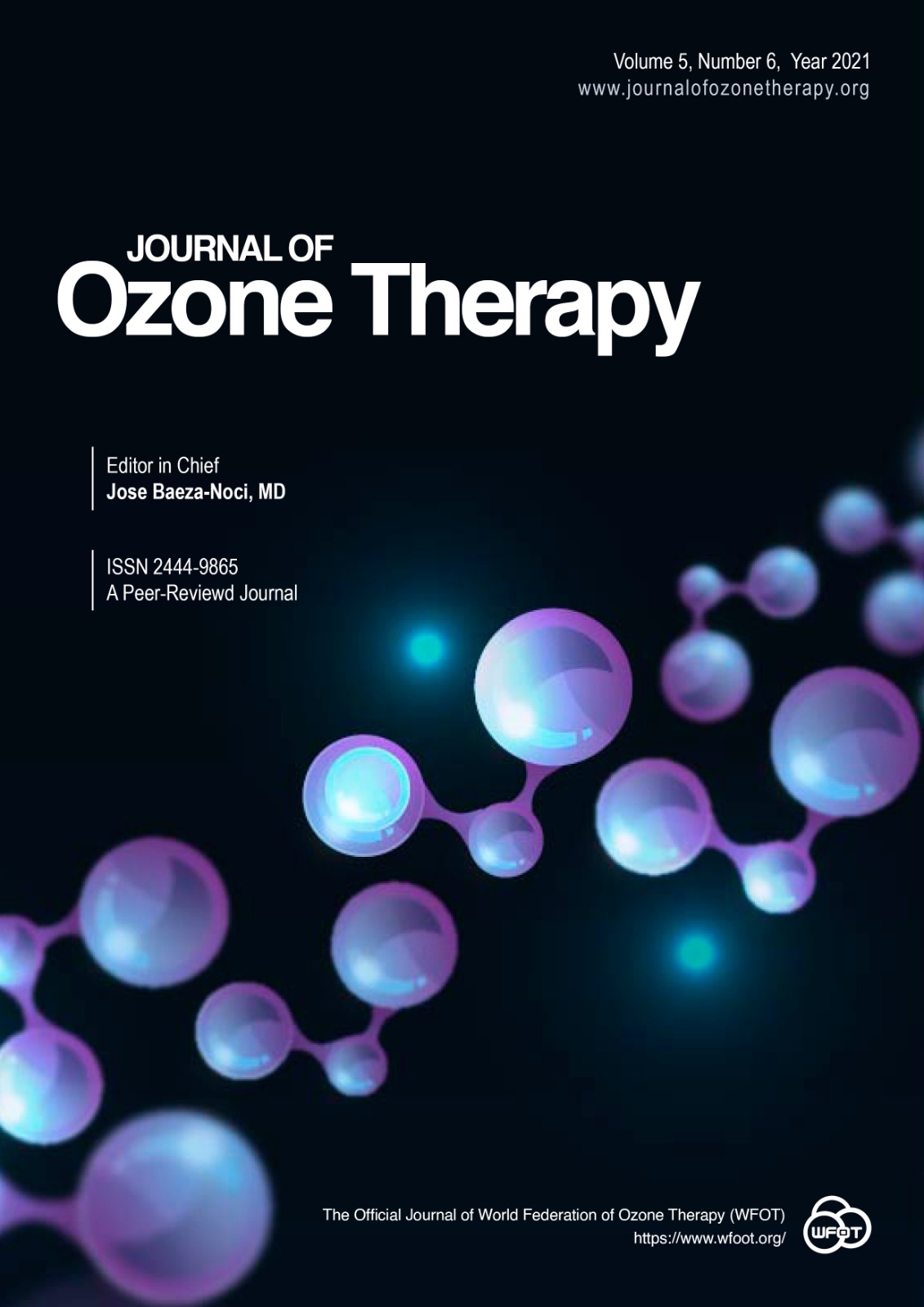Doping that it not a doping. Effects of ozone therapy in sportmen.
DOI:
https://doi.org/10.7203/jo3t.5.6.2021.21386Keywords:
ozone, sportive performance, professional sport, oxygen carrier, training, WADA list Abstract
Abstract
Objectives
The primary objective of this study was measuring the contribution of ozone therapy to athletic performance.
Methods
At the beginning, we conducted a performance measurement (Astrand Treadmill Test) of the 30 (thirty) Football Players actively playing in the Turkish National League (men U19 Players of Premier League and 1st Football League Teams). After the primary measurement, 15 players were selected randomly and treated with 20 µg/ml to 30 µg/ml Major Ozone Autohemotherapy, 2 times a week for 5 weeks. The other 15 players were designated as the control group. At the end of the process, Astrand Treadmill Test was repeated with the same players on the 8th week, and their measurements were taken and compared with the first results. Results for first day average VO2 max was 51 mL/kg/min for each group. After 8 weeks, first group’s VO2 Max found averagely 61 mL/kg/min. Control group’s average VO2 Max was found 54 mL/kg/min. In the first measurement, max running time was average 25 min. for each group, and after 8 weeks it was measured as 32 min. average for the first group, and 28 min. average for the control group.
Conclusion
The difference in performance increase was found significant between football players who were treated and not treated with ozone therapy. All athletes performed the same training program for 8 weeks. VO2max was increased %28 in ozone therapy-treated athletes but it was increased %12 in the control group. Max running time was increased %20 at ozone therapy-treated athletes, and it was increased %6 in the control group. In terms of these results, we can say that ozone therapy will be very effective for increasing athletic performance before season or tournaments.
 Downloads
Downloads
 References
References
Bocci V, Luzzi E, Canadeschi F et al. Studies on the biological effects of ozone. Biotherapy. 1994;7:83-90.
Bocci V. Compressione dei meccanismi di azione e possibilità terapeutiche. In: Bocci V Ossigeno-Ozonoterapia. Rozzano, Italy: Casa editrice Ambrosiana; 2000. p 161-163.
Bocci V. Oxygen-Ozone Therapy. A critical evaluation. Dordrecht, The Netherlands: Kluwer Academic Publishers; 2002.
Re L. Oxygen-ozone therapy in sport. A case report. Riv It Ossigeno-Ozonoter. 2005 Apr;4(1):59-63.
Bocci V. Ozone as Doping in Athletes. In: Bocci V. Oxygen-Ozone Therapy. A critical evaluation. Dordrecht, The Netherlands: Kluwer Academic Publishers; 2002. p. 341.
Aydın T, Yıldız Y, Kalyon TA. Spor Yaralanmaları. Ankara: GATA Basımevi, GATA Yayınları, Ayın Kitabı; 2000, p. 1-2.
Jafari A, Faizib, MAH, Askariana F, Pourrazic H. Effect of regular aerobic exercise with ozone exposure on peripheral leukocyte populations in wistar male rats. Int J Res Med Sci. 2009;14(5):277-283.
Pressman, S. Ozone benefits for athletes [Internet] [cited 2021 Apr 12]. Available from: http://www.o3center.org/ConditionsCenter/MusculoSkeletalSystems/Ozonebenefitsforathletes.html
Şenyüz, B. Sporcu sağlığı ve performans artırımında ozonterapinin yeri [Internet] [cited 2021 Apr 12]. Available from: http://www.ozonklinik.com/tr/ozon-klinik-makale/spor-ve-ozon-tedavisi/
Bowman C. Oxygen Treatment for Athletes [Internet] [cited 2021 Apr 12]. Available from: http://www.austinfitmagazine.com/October-2015/Oxygen-Treatment-for-Athletes/
Gjonovich A, Sallusti G, Brusomini A. Effect of major autohaemotherapy with oxygen-ozone on the anaerobic threshold in athletes. Riv It Ossigeno-Ozonoter. 2006;5:12-16.
Astrand, P.O. Experimental studies of physical working capacity in relation to sex and age. Munksgaard, Copenhagen. 1952.
Astrand P.O., Cuddy T. E., Saltin B., Stenberg J. (1964) Cardiac output during submaximal and maximal work. J Appl Physiol. 1964;19:268–274.
Heywood V. The Physical Fitness Specialist Manual. The Cooper Institute for Aerobics Research. Dallas TX, revised 2005. In: Heywood V. Advanced Fitness Assessment and Exercise Prescription. 5th ed. Champaign: Human Kinetics; 2006. p. 52-56.
Wilmore JH, Costill DL. Physiology of Sport and Exercise. 3rd ed. Champaign: Human Kinetics; 2005.
World anti-doping agency. The prohibited list [Internet] [cited 2021 Apr 12]. Available from: https://www.wada-ama.org/en/what-we-do/the-prohibited-list.
Wikipedia. Ion Cuțelaba [Internet] [cited 2021 Apr 12]. Available from: https://en.wikipedia.org/wiki/Ion_Cu%C8%9Belaba.
Downloads
Published
How to Cite
-
Abstract1035
-
PDF1440
Issue
Section
License
Journal of Ozone Therapy applies the Creative Commons Attribution-NonCommercial 4.0 International License (CC BY NC 4.0) license to works we publish.
Under this license, authors retain ownership of the copyright for their content, but allow anyone to download, reuse, reprint, modify, distribute and/or copy the content as long as the original authors and source are cited. No permission is required from the authors or the publishers.
You may not use the material for commercial purposes.
Appropriate attribution can be provided by simply citing the original article, provide a link to the license, and indicate if changes were made.
You may do so in any reasonable manner, but not in any way that suggests the licensor endorses you or your use.




